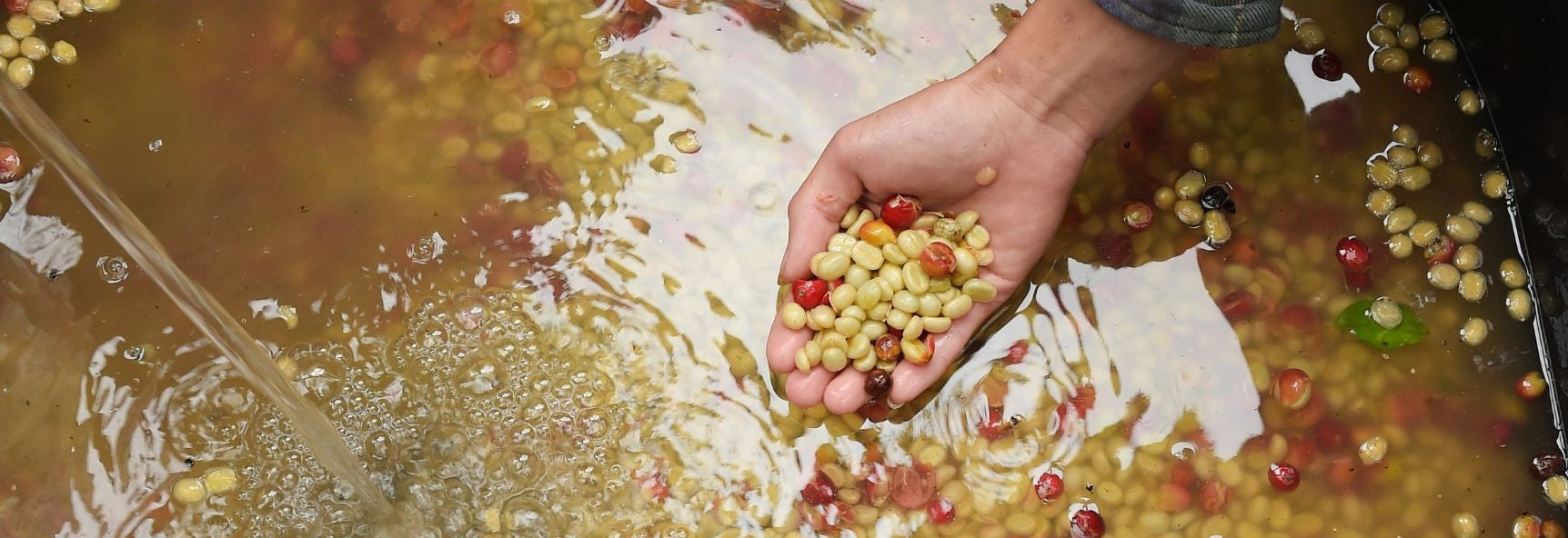Wet Process/Washed Coffee
What is Washed Coffee?
Washed coffee, also known as wet-processed coffee, is a method of processing coffee beans that involves removing the fruit layer from the seeds (beans) before they are dried. In this process, freshly harvested coffee cherries are first de-pulped to remove the outer skin and most of the fruit flesh. After washing, the beans are dried in the sun or using mechanical dryers. This method tends to produce a cleaner, brighter, and more acidic flavour profile, highlighting the coffee bean's inherent qualities.
What Steps Are Involved in Wet Processing/Washing Coffee Beans?
After harvest, the cherries pass through water channels. The ripe fruit sinks to the bottom, while the unripe and defective cherries float on top and are easily removed. Next, a mechanical de-pulping machine removes the fruit pulp, leaving only the mucilage, the sticky layer surrounding the seed, similar to what covers a peach stone. The beans are then soaked in fermentation tanks for 8-50 hours to remove the mucilage. After this step, they rinse the green beans again before sending them to dry, which can take 5 to 15 days, depending on conditions.
What Are the Benefits of Washed Coffee Processing?
Each type of coffee processing brings pros and cons. Here are some of the benefits of the washed process.
- Consistency: The washed process makes it easier to remove defective cherries before drying, giving washed coffee better consistency. Natural processed coffees can have cherries ripen at different speeds, meaning some go bad alongside still-ripe cherries, spoiling them. However, farming techniques in Naturals have improved dramatically over time.
- Clarity: Washed coffees offer excellent clarity of flavour and highlight the essential role of good farming and origin. With other processes like Natural and Honey, some of the fruit is left on during the drying stage, boosting fermentation and adding to the final flavour. Because all of the fruit is removed before drying in the washed method, all the flavours of the cherry must be imparted into the bean during the plant's growth.
- Labour Intensity: Natural processed coffees must be monitored and turned consistently during drying to ensure they dry evenly. This makes the Washed process less labour intensive. However, not all regions are suited to this method as it requires access to a lot of water.
You can read more about the different types of processes here and why certain regions choose different methods.
What Are the Different Types of Coffee Bean Processing?
Generally speaking, there are three main processes: natural, washed, and honey. However, the coffee industry is always dynamic, and new processes are constantly popping up. Here's a breakdown of some of the processes in your favourite FiXX.
Washed (wet process)
This is what we're talking about today, where all of the fruit is removed before drying. Because of this, all the fruit's flavour must be imparted into the bean during the growing phase, thus highlighting the importance of good farming. Washed coffees are prized for their clarity of flavour. Found in FiXX Oslo/Seattle.
Natural (dry process)
This is where all of the fruit is left on the green bean while drying. This boosts fermentation and gives natural coffees potent berry and fruity notes. Found in FiXX Lisbon.
Honey (pulped natural/ semi-washed)
This process is like a bridge between natural and washed processing. First, the beans are de-puled, leaving behind a layer of mucilage, which gives them a sticky, honey-like texture. The beans are then dried with this mucilage still attached, resulting in a coffee with a unique flavour profile that combines characteristics of both washed and natural processing methods, often featuring sweetness, fruitiness, and complexity. Found in FiXX Single Origin.
Giling Basah (wet-hulled)
This coffee processing method is commonly used in Indonesia. In this method, coffee cherries are pulped, leaving some mucilage on the beans. The beans are then dried to a moisture content of around 30-35%, resulting in a distinct flavour profile with earthy and spicy notes. Found in FiXX Classic.
Anaerobic fermentation
Anaerobic fermentation in coffee processing involves fermenting coffee beans in a sealed, oxygen-deprived environment. This process leads to unique flavour profiles in coffee, influenced by duration, temperature, and microbial activity. The resulting coffee has a complex flavour profile with pronounced acidity, fruitiness, and sweetness. Found in FiXX Single Origin.
What Flavours Can Be Found in Washed Process Coffee?
Coffee plants reflect the specific characteristics of the region where they are grown. Some regions produce coffee with citrusy or fruity notes, while others have chocolaty or floral flavours. This is one of the reasons why coffee is cherished worldwide. Even though two coffee beans may look the same, their taste can be wonderfully different, making it challenging to pinpoint "typical" flavours for washed processed coffees.
However, the clarity of flavour they showcase sets washed coffees apart from other processes. By removing the fruit before drying, fermentation is significantly reduced, and the intrinsic qualities of the coffee beans are preserved, resulting in a cleaner and more defined flavour. Washed coffees are often characterised by bright acidity, vibrant citrus and floral notes, and a refined sweetness. These flavour characteristics make washed coffees highly prized for their clarity and complexity.





